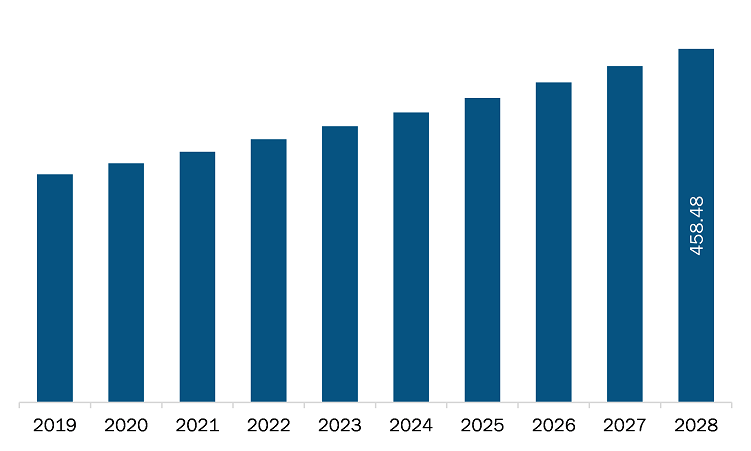The xanthan gum market in Asia Pacific is expected to grow from US$ 325.07 million in 2021 to US$ 458.48 million by 2028; it is estimated to grow at a CAGR of 5.0% from 2021 to 2028.
Xanthan gum is commonly utilized in oil recovery and oil drilling applications for many reasons, including reducing water mobility and improving stability against salt, temperature, and shear. In addition, xanthan gum is commonly used as a thickening agent in drilling mud to increase viscosity. It helps to improve oil flow by swelling and forming a gel-like consistency, making it easier for oil to flow and reducing prices. Xanthan gum market mud additive is very effective and environmentally friendly, with a high tolerance for harsh drilling conditions such as temperature fluctuations, acidity, and alkalinity, which is further boosting its demand in the oil & gas industry. Further, the increasing demand for sustainable solutions in the oil and gas industry, as well as increased measures to improve brand image, are expected to drive the demand for xanthan gum. Xanthan gum is frequently utilized in upstream oil & gas activities since it facilitates the refining of raw crude oil. Furthermore, because of its high resonance with water and synthetic chemicals, and non-toxic nature, it is an effective alternative to corrosive and poisonous solutions, which is expected to increase the market share. Additionally, the rising oil & gas drilling activities in India and China are expected to boost the demand for xanthan gum in the coming years. Thus, the growing demand for xanthan gum for the oil & gas drilling industry is creating new opportunities for the manufacturers in the market.
The outbreak of COVID-19 is wreaking havoc on the economic growth of Asia Pacific. The severity of the consequences and impact is entirely dependent on the transmission of the novel coronavirus. Various governments in Asia Pacific are considering taking actions to limit the spread by imposing lockdowns, which is slowing down the operations of various industries in the region. This factor is anticipated to severely impact the growth of regional market. However, with increasing recovery rates, governments are easing out restrictions imposed on various industrial operations which is expected to create a positive impact for the growth of xanthan gum market across the region.
With the new features and technologies, vendors can attract new customers and expand their footprints in emerging markets. This factor is likely to drive the Asia Pacific xanthan gum market. The Asia Pacific xanthan gum market is expected to grow at a good CAGR during the forecast period.

- This FREE sample will include data analysis, ranging from market trends to estimates and forecasts.
Asia Pacific Xanthan Gum Market Segmentation
Asia Pacific Xanthan Gum Market – By Form
- Dry
- Liquid
Asia Pacific Xanthan Gum Market – By Application
- Food and Beverages
- Oil and Gas
- Pharmaceuticals and Nutraceuticals
- Personal Care
- Others
Asia Pacific Xanthan Gum Market – By Country
- Australia
- China
- India
- Japan
- South Korea
- Rest of APAC
Asia Pacific Xanthan Gum Market – Companies Mentioned
- ADM
- Cargill, Incorporated
- CP Kelco
- Deosen
- FUFENG GROUP
- HEBEI XINHE BIOCHEMICAL CO. LTD
- Ingredion Incorporated
- Solvay
- UNIONCHEM
Asia Pacific Xanthan Gum Report Scope
| Report Attribute | Details |
|---|---|
| Market size in 2021 | US$ 325.07 Million |
| Market Size by 2028 | US$ 458.48 Million |
| CAGR (2021 - 2028) | 5.0% |
| Historical Data | 2019-2020 |
| Forecast period | 2022-2028 |
| Segments Covered |
By Form
|
| Regions and Countries Covered |
Asia-Pacific
|
| Market leaders and key company profiles |
|
- Historical Analysis (2 Years), Base Year, Forecast (7 Years) with CAGR
- PEST and SWOT Analysis
- Market Size Value / Volume - Regional, Country
- Industry and Competitive Landscape
- Excel Dataset
Recent Reports
Testimonials
Reason to Buy
- Informed Decision-Making
- Understanding Market Dynamics
- Competitive Analysis
- Identifying Emerging Markets
- Customer Insights
- Market Forecasts
- Risk Mitigation
- Boosting Operational Efficiency
- Strategic Planning
- Investment Justification
- Tracking Industry Innovations
- Aligning with Regulatory Trends





















 Get Free Sample For
Get Free Sample For